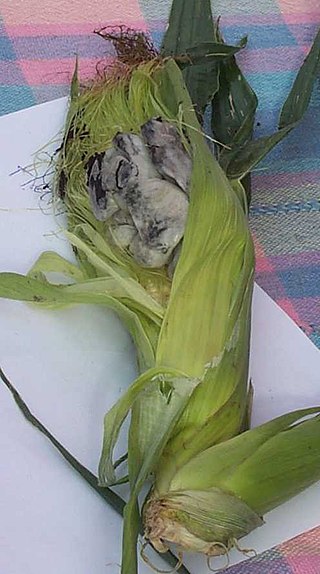
Streptomyces is the largest genus of Actinomycetota, and the type genus of the family Streptomycetaceae. Over 700 species of Streptomyces bacteria have been described. As with the other Actinomycetota, streptomycetes are gram-positive, and have very large genomes with high GC content. Found predominantly in soil and decaying vegetation, most streptomycetes produce spores, and are noted for their distinct "earthy" odor that results from production of a volatile metabolite, geosmin. Different strains of the same species may colonize very diverse environments.

Natamycin, also known as pimaricin, is an antifungal medication used to treat fungal infections around the eye. This includes infections of the eyelids, conjunctiva, and cornea. It is used as eyedrops. Natamycin is also used in the food industry as a preservative.

The avermectins are a series of drugs and pesticides used to treat parasitic worm infestations and to reduce insect pests. They are a group of 16-membered macrocyclic lactone derivatives with potent anthelmintic and insecticidal properties. These naturally occurring compounds are generated as fermentation products by Streptomyces avermitilis, a soil actinomycete. Eight different avermectins were isolated in four pairs of homologue compounds, with a major (a-component) and minor (b-component) component usually in ratios of 80:20 to 90:10. Avermectin B1, a mixture of B1a and B1b, is the drug and pesticide abamectin. Other anthelmintics derived from the avermectins include ivermectin, selamectin, doramectin, eprinomectin.

The Ustilaginaceae are a family of smut fungi in the order Ustilaginomycetes. Collectively, the family contains 17 genera and 607 species.

Streptomyces natalensis is a bacterial species in the genus Streptomyces.

Streptomyces viridochromogenes is a bacterium species in the genus Streptomyces.

1-Deoxynojirimycin, also called duvoglustat or moranolin, is an alpha-glucosidase inhibitor, most commonly found in mulberry leaves. Although it can be obtained in small quantities by brewing an herbal tea from mulberry leaves, interest in commercial production has led to research on developing mulberry tea higher in DNJ, and on alternate routes of production, such as via Bacillus species.
Streptomyces isolates have yielded the majority of human, animal, and agricultural antibiotics, as well as a number of fundamental chemotherapy medicines. Streptomyces is the largest antibiotic-producing genus of Actinomycetota, producing chemotherapy, antibacterial, antifungal, antiparasitic drugs, and immunosuppressants. Streptomyces isolates are typically initiated with the aerial hyphal formation from the mycelium.
Streptomyces albulus is a bacterium species from the genus of Streptomyces. Streptomyces albulus produces acetoxycycloheximide, aciphenol, albanoursin and cycloheximide.
Streptomyces ambofaciens is a bacterium species from the genus Streptomyces which has been isolated from soil from France. Streptomyces ambofaciens produces ambobactin, foromacidin A, foromacidin B, foromacidin C, 18-deoxospiramicin I, 17-methylenespiramycin I and congocidin.
Streptomyces cacaoi is a bacterium species from the genus of Streptomyces. Streptomyces cacaoi produces polyoxine.
Streptomyces diastaticus is an alkaliphilic and thermophilic bacterium species from the genus of Streptomyces. Streptomyces diastaticus produces oligomycin A, oligomycin C, rimocidin and the leukotriene-A4 hydrolase-inhibitor 8(S)-amino-2(R)-methyl-7-oxononanoic acid. Streptomyces diastaticus also produces gougerotin and diastaphenazine and the antibiotic ruticin.
Streptomyces diastatochromogenes is a bacterium species from the genus of Streptomyces. Streptomyces diastatochromogenes produces polyketomycin, concanamycin A, concanamycin B, concanamycin C, momofulvenone A, azdimycin, toyocamycin and oligomycins.
Streptomyces griseocarneus is a bacterium species from the genus of Streptomyces which has been isolated from soil. Streptomyces griseocarneus produces hydroxystreptomycin, alboverticillin, sphingomyelinase C and rotaventin.
Streptomyces jiujiangensis is a bacterium species from the genus of Streptomyces which has been isolated from rhizosphere soil from a pine tree from the Mount Lu in the Jiangxi province in China. Streptomyces jiujiangensis produces antialgal compounds.
Streptomyces laurentii is a bacterium species from the genus of Streptomyces which has been isolated from soil. Streptomyces laurentii produces thiostrepton.
Streptomyces olivaceoviridis is a bacterium species from the genus of Streptomyces which has been isolated from soil. Streptomyces olivaceoviridis produces chitinase and xylanase.
Streptomyces viridosporus is a bacterium species from the genus of Streptomyces. Streptomyces viridosporus produces sistomycine and lignin peroxidase. Streptomyces viridosporus can degrade lignin and humic acids. Streptomyces viridosporus also produces moenomycin A, a component of bambermycin.

A jadomycin is a natural product produced by Streptomyces venezuelae ISP5230 (ATCC10712), the organism which is most well known for making the antibiotic chloramphenicol. The name jadomycin is applied to a family of related angucyclines which are distinguished by the E ring, which is derived from an amino acid. The amino acid incorporation which forms the E-ring is a chemical reaction, rather than enzymatic, an uncommon occurrence in biosynthesis. As such a number of jadomycins incorporating different amino acids have been discovered. Jadomycin A was the first compound of this family to be isolated and constitutes the angucylic backbone with L-isoleucine incorporated into the E-ring. A related analog, jadomycin B, is modified by glycosylation with a 2,6-dideoxy sugar, L-digitoxose. Jadomycins have cytotoxic and antibacterial properties.
Microbial hyaluronic acid production refers to the process by which microorganisms, such as bacteria and yeast, are utilized in fermentation to synthesize hyaluronic acid (HA). HA is used in a wide range of medical, cosmetic, and biological products because of its high moisture retention and viscoelasticity qualities. HA had originally been extracted from rooster combs in limited quantities. However, challenges such as low yields, high production costs, and ethical issues associated with animal-derived HA has driven the development of microbial production methods for HA.







